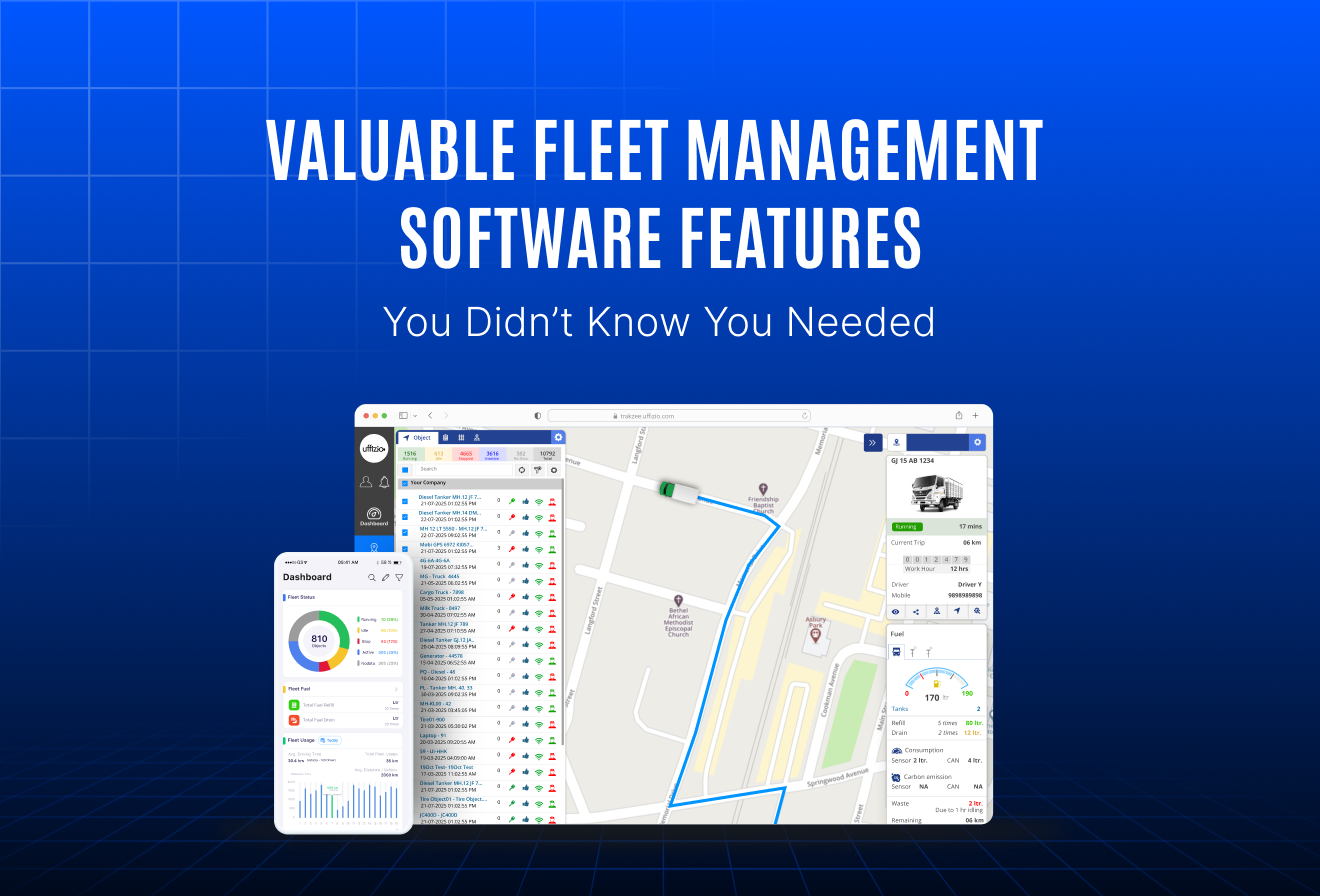Valuable fleet management software features you didn’t know you needed

When we think about fleet management software, we often highlight the usual suspects — fuel monitoring, tire pressure alerts, or video telematics. However, there are several equally valuable features that don’t get as much attention but significantly improve day-to-day operations, compliance, and maintenance.
Here are 9 essential fleet management software features that deliver real impact — even if they aren’t always in the spotlight.
1. Driver management
Driver management goes beyond monitoring driving behavior — it enables centralized control over all driver-related data. From license renewals and compliance status to task assignments and performance metrics, this module supports smooth driver operations and accountability.
Key functionalities include:
- Assigning drivers based on skill, availability, and vehicle type
- Monitoring working hours, attendance, and driving documentation
- Setting restrictions for regulatory compliance and internal safety standards
- Tracking driving metrics to optimize workforce allocation
Especially helpful for large fleets with rotating drivers across assets or shifts.
2. Technician management
Managing technicians directly through the software helps automate repair workflows and reduce vehicle downtime. The module tracks service tasks, repair logs, and technician performance to streamline workshop operations.
Key functionalities include:
- Allocating tasks by technician availability and expertise
- Tracking repair progress in real-time
- Maintaining detailed expense logs and service records
- Assigning profiles and permissions for better operational control
Ideal for fleets handling in-house maintenance or multiple workshops.
3. Fleet reminders
With hundreds of maintenance schedules, document renewals, and inspections to manage, reminders are a must. This feature ensures nothing slips through the cracks.
Key functionalities include:
- Setting personalized service, renewal, or compliance alerts
- Linking reminders to specific vehicles or asset groups
- Customizing recurrence and severity of alerts
Reduces the risk of fines, delays, or equipment damage due to missed schedules.
4. Parts inventory management
This feature simplifies the control and flow of spare parts. It ensures stock is always ready for critical maintenance while minimizing waste and costs from overstocking.
Key functionalities include:
- Monitoring the availability of spares, tools, or devices
- Linking sold, used, and stored inventory with maintenance tasks
- Managing renewals and purchase requests in advance
- Aligning stock with ongoing fleet operations for better planning
Supports lean inventory strategies without disrupting service timelines.
5. Expense management
Expense tracking within the software enables a clear view of fleet spending. It helps fleet managers analyze, categorize, and control costs in real-time.
Key functionalities include:
- Uploading expense records (fuel, tolls, repairs, etc.)
- Categorizing costs for accurate budgeting
- Linking spending with specific vehicles or operations
- Generating detailed analytics and custom reports
Makes financial audits and monthly cost evaluations far easier to handle.
6. Customised API integration
As fleet systems grow, integration becomes key. A robust API feature enables seamless connection between the fleet software and other third-party platforms like CRMs, ERPs, and sensor dashboards.
Key functionalities include:
- Creating push/pull data endpoints
- Automating actions across systems (alerts, reports, billing, etc.)
- Configuring secure access and permissions
- Fetching reports or live data via external APIs
Crucial for system integrators managing multiple platforms for enterprise clients.
7. Base location configuration
This feature brings geographical organization into play. By grouping vehicles and operations around specific base locations, fleets can manage region-specific resources more efficiently.
Key functionalities include:
- Assigning vehicles, drivers, or technicians to base locations
- Creating reports per zone or branch
- Planning dispatch and routes more effectively
Especially useful for fleets operating across multiple branches or cities.
8. Compliance configuration tools
Compliance isn’t optional — and manual checks just don’t scale. This module helps ensure all fleet operations align with regional laws and transport safety guidelines.
Key functionalities include:
- Mapping and adapting to regional standards (EU, ELD, AIS-140, etc.)
- Auto-generating reports for audits and government checks
- Monitoring driver working hours, maintenance status, and documentation
- Triggering alerts for non-compliant activities
Reduces legal risks and boosts confidence in large contract bids.
9. Integration capabilities
An underrated enabler — integration tools allow data from various sources (hardware, IoT devices, toll systems, etc.) to flow smoothly into the fleet platform.
Key functionalities include:
- Support for hardware-agnostic integrations (sensors, locks, etc.)
- Compatibility with business software ecosystems
- Syncing data across modules for a unified experience
Ensures no feature or device sits in isolation, enabling better cross-platform performance.
Operational success lies in managing the smallest details
While these features may seem like small operational details on the surface, their collective impact on fleet management is anything but minor. Each tool plays a strategic role in reducing manual oversight, preventing costly errors, and ensuring day-to-day operations run smoothly. Whether it’s automating a simple service reminder, configuring a base location, or tracking a technician’s task history, these functionalities help build a system that is proactive rather than reactive. By paying attention to these finer aspects, fleet operators gain better visibility, faster decision-making, and long-term cost control — ultimately creating a more resilient and efficient fleet ecosystem.
Unlocking value: Why these features are great for business growth
For businesses offering fleet management solutions, having a well-rounded feature set isn’t just about functionality — it’s also a competitive advantage. Each of the lesser-highlighted features discussed above can serve as a strong talking point during sales discussions and product demos.
Here’s how:
- Stronger Positioning in Sales Conversations
Offering tools like driver and technician management, expense tracking, or inventory control allows for more tailored sales pitches. These features directly speak to the real-world pain points of fleet operators and showcase depth beyond just GPS tracking. - Enhanced Client Retention
When clients discover time-saving features like fleet reminders or customizable APIs during implementation, they are more likely to stay long-term. These “bonus capabilities” often exceed expectations and reinforce product value. - Flexibility to Serve Niche Segments
Features like base location grouping or compliance configuration make it easier to target diverse industries — from public transport to field service companies — each with unique operational needs. - Simplified Scalability & Integration
With robust integration capabilities and modular API support, businesses can easily adapt the solution to different markets, scale to new regions, or integrate with clients’ existing tools — all without custom development from scratch.
The real strength of these features lies not just in how they work, but in how they elevate the overall offering — making the software easier to market, easier to scale, and more valuable to potential clients.
Conclusion
These lesser-discussed features often form the backbone of successful fleet operations. From automating alerts and managing drivers to integrating complex data systems, they simplify workflows and unlock hidden efficiencies.
Whether you manage a small fleet or a multi-location operation, exploring these features can help you get more out of your fleet management software — without needing more tools.




